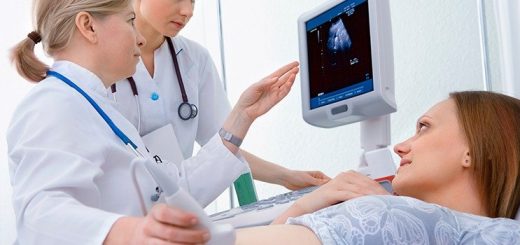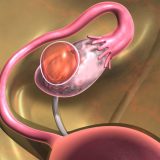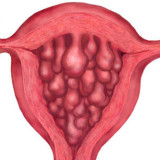Sometimes ovarian cyst during pregnancy disappear by itself. Sometimes, under the influence of sex hormones, it develops. In this case, surgical intervention is required. Cysts on reproductive organs in women are benign tumors that can be filled with fluid, blood, pus, or tissue. Cysts less than a centimeter may just be part of a healthy ovary.
Types of the cysts
In most cases the cysts are formed on the outer wall of the ovaries or inside them. Relatively rarely, cysts are diagnosed on the labia. They can also appear on the so-called Bartoline glands. Such cysts occur as a result of inflammation of the gland. In addition, ovarian cysts during pregnancy can occur in the muscles and cervix, vaginal wall, as well as in the fallopian tubes.
There are those cysts that cause extremely painful sensations, unpleasant symptoms and require treatment. For example, chocolate cyst is a symptom of endometriosis. This abnormal growth of endometrial tissue or mucosa. Endometriosis reduces the likelihood of conception and complicates the course of pregnancy, causing problems such as menstrual irregularities, painful menstruation and intermenstrual bleeding.
Another common type of cyst is small cysts that appear in polycystic ovary syndrome (PCOS). This disorder also causes difficulties in pregnancy and menstrual disorders, as well as excessive weight gain and excessive hair growth (hirsutism).
More often women have ovarian cyst. Only 10-15% of the cysts are malignant. Therefore, immediate surgery is not required, instead, it is recommended to see a doctor and sometimes hormonal treatment.
However, any ovarian cysts can adversely affect their functioning, which is manifested, among other things, in violation of the menstrual cycle. In addition, ovarian cyst during pregnancy can cause miscarriage or premature birth.
Causes & symptoms
Ovarian cysts usually occur when the mature follicle does not rupture. It usually contains a dead egg or does not have one at all. The cause of the cysts are most often hormonal disorders.
Ovarian cysts of the small size do not give any symptoms, as a rule. Large ovarian cysts can cause unilateral, pulling abdominal pain, intermenstrual bleeding, pain during sexual intercourse.
Symptoms of cysts during pregnancy are:
- non-physiological cramps and abdominal pain,
- discharge from the genital tract,
- pain during sexual intercourse,
- feeling of pressure on the internal organs.
Ovarian cyst during pregnancy
Ovarian cyst occurs mainly in women of childbearing age. It appears in one of thousands of women during pregnancy. In most cases, ovarian cyst during pregnancy is harmless. However, in rare cases, cysts, due to their size, can begin to cause anxiety symptoms, as well as turn into cancer.
Many pregnant women do not know about the presence of the cysts until they are discovered by a doctor. But even when the cyst is detected, there is a high probability that this tumor will not affect the pregnancy. Almost all the cysts decrease in size and disappear before the date of the birth.
Of course, there is a possibility that the cyst will become malignant, but the risk is negligible. Recent studies have shown that only one in 25 000 of the cysts turns into a cancer. That is why doctors usually limit the cyst treatment with monitoring the ovarian cyst during pregnancy and advising the patient on how to deal with the disease symptoms.
Diagnostics
Ovarian cyst during pregnancy is detected by medical ultrasound. If the procedure shows that the cyst is filled with fluid and has thin walls, it is most likely a completely benign cyst. However, it should be checked from time to time to keep track of any changes.
The risk is also that the ovarian cyst during pregnancy may rupture or twist. This can lead to premature birth and even miscarriage.
Treatment
In the case of the large cyst, not decreasing for several weeks, surgical removal is recommended. The operation is usually carried out when the changes reach 6-8 cm. The operation itself is painless and not dangerous for the mother and child, especially if it is carried out before the middle of the second pregnancy trimester.
Ovarian cyst during pregnancy is removed by laparoscopy. Less often the invasive surgery is used, only in the case of very large ovarian cysts.
Surgical treatment is also used if there are severe symptoms. It can be bleeding, pain in the mammary glands, nausea, vomiting, severe headaches and pain in the lower abdomen.
Hormonal treatment is used if the cyst is caused by a disease associated with hormonal fluctuations.
However, before starting treatment, the doctor usually monitor the condition and size of the cyst until the end of the second trimester of pregnancy, preferably from 14 to 16 weeks.
How to deal with the symptoms
In case of severe pain caused by ovarian cyst during pregnancy doctors prescribe painkillers containing paracetamol.
It can also help to apply hot compresses to the lower back to reduce discomfort.
It is also desirable to avoid those types of physical activity that can exacerbate the symptoms associated with the presence of ovarian cyst.















